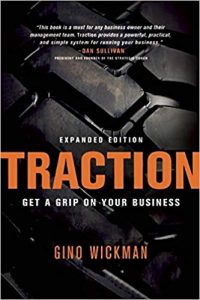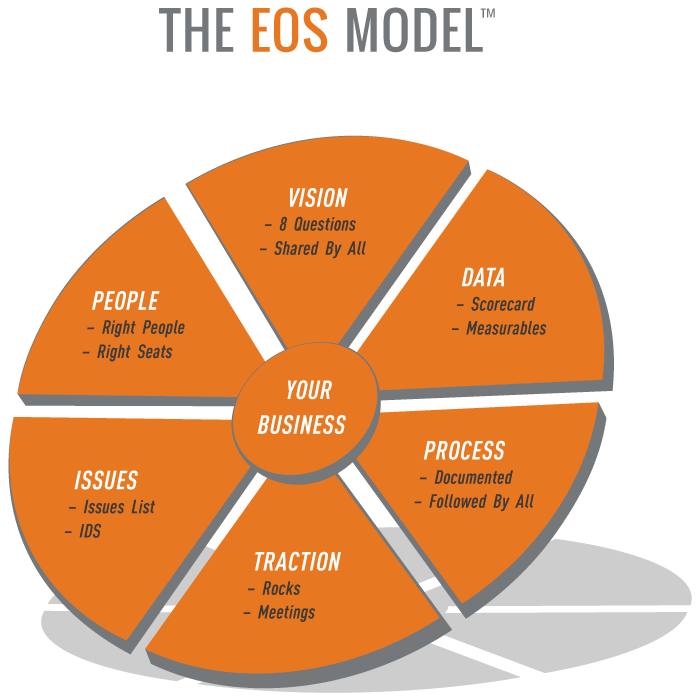 Several clients and trusted partners we work with have recently implemented some of the ideas discussed in the 2011 book, Traction: Get a Grip on Your Business by Gino Wickman. The book introduces an Entrepreneurial Operating System (EOS)® that small and medium-sized enterprises can use to simplify how they grow their business.
Several clients and trusted partners we work with have recently implemented some of the ideas discussed in the 2011 book, Traction: Get a Grip on Your Business by Gino Wickman. The book introduces an Entrepreneurial Operating System (EOS)® that small and medium-sized enterprises can use to simplify how they grow their business.
EOS® simplifies the many aspects of an organization into six core components as shown below. We will explain these six components and how they work together in a powerful system. EOS contains good tools for a small business if you don’t already have a management system. None of the six components in EOS are novel, but the overall system uses the KISS method (Keep it Simple, Stupid) to help a business owner focus.

VISION
A business leader needs to have a vision for the organization and also communicate it to the people who work with them. While this seems fundamental, we are amazed at how often this is not done well.
We encourage you to try the simple test below in your organization.
2020 VISION TEST
Ask five people who work for you the following three questions:
- What is the core focus of the business?
- What are the three most important differentiators for our business versus alternatives?
- What is our revenue and number of employees now, and what are our goals for five years from now?
We have yet to meet a leader whose answers match up with the rest of the people in his or her organization.
Alignment in the organization is critical and fully the responsibility of leadership. EOS recommends forming and sharing a three-year vision for the organization.
PEOPLE
EOS uses the Jim Collins principle from Good to Great to first, get the right people on the bus and then get them in the right seats.
You make sure you have the right people on the bus by evaluating them based on the core values of the organization. If people on your team do not believe in or demonstrate these core values, then you must provide feedback and give the individual a chance to correct their behavior. If they don’t change, however, you must replace them on your bus.
Once you have the right people on the bus, get them in the right seats by ensuring they:
“Get it” – understand the job requirements and challenges of the position.
“Want it” – accept the role and like the challenges.
“Have the capacity to do it” – have the time and mental, physical and emotional capacity to do the job well.
Note that for many small businesses people fill several roles. Ask these three questions for each role and ensure you have good answers.
DATA
Lean East and the entrepreneurial operating system both recommend leaders focus on a simple scorecard or dashboard of 5-15 key organizational metrics. Metrics are critical for a business in several ways:
- To know your score and how to advance in the game of business
- So you can set goals and see how you are performing
- You can’t evaluate a change if you don’t have a baseline to compare to
EOS recommends everyone in the business have a “number.” Numbers provide clarity, teamwork, friendly competition, and also accountability. Learn more by reading our post about creating Key Performance Indicators.
ISSUES
Firstly, every organization has issues. EOS recommends naming and tracking your issues in one of three lists:
- Long term (greater than 90-day) issues that leadership identifies when setting the vision.
- Shorter-term (7-to-90 day) issues identified in a weekly leadership team meeting.
- Shorter-term, departmental level issues that are solved locally and do not rise to the leadership team level.
Issues are resolved using a three-step IDS™ process:
- Identify – ensure you understand the problem at its root level.
- Discuss – keep this step short! Focus more on identifying the root causes rather than lots of discussion about the issue. Avoid tangents.
- Solve – add the action that comes from your discussion to a to-do list that will ensure the issue is resolved.
Many organizations get caught up discussing issues without solving them. Action is key.
PROCESS
Great organizations need excellent and consistent processes. You should say what you do and do what you say. The EOS process® for documenting your core processes is:
- Schedule an hour with your leadership team to identify your core processes. Do this together to agree on what to call each process. Examples are the HR process, the sales process, the marketing process, the customer retention process, the accounting process, etc.
- Document each of the core processes. Lean East has described many good ways to do this, including posts about A3 Process Improvement, experimenting using the improvement cycle and Ready…Fire!…Aim.
- Package your work from the previous two steps and test it with the team involved.
Everyone on the leadership team must commit to following organizational processes. Ensure people are retrained and managed to follow the process. Once the processes become standardized in a small business, then it is easier for an owner to reduce their personal workload while still achieving great results.
Note that EOS only devotes a few pages to the process. It is a simplistic view of process improvement only appropriate for a very small business. Lean East has far more knowledge and resources to share in this area.
TRACTION
Action is the process of doing. The previous components of the EOS only succeed with the accountability and discipline to turn a vision into a reality. Lean East would agree with the entrepreneurial operating system opinion that this is where many organizations struggle the most. EOS focuses on accountability, communication, organization and Traction® using the concept of Rocks and a Meeting Pulse.
 Rocks are your most important priorities and the things you must schedule first before all the urgent and not important alternatives (see the Stephen Covey 7-Habits of Highly Successful People for more information about rocks.) An organization or team should only focus on 3-7 rocks at a time; an individual on no more than 1-3. Here is the priority for establishing your rocks:
Rocks are your most important priorities and the things you must schedule first before all the urgent and not important alternatives (see the Stephen Covey 7-Habits of Highly Successful People for more information about rocks.) An organization or team should only focus on 3-7 rocks at a time; an individual on no more than 1-3. Here is the priority for establishing your rocks:
- After reviewing the vision together, identify the items you want to close out over the next 90-days.
- With the list in front of you, determine the 3-7 most important to accomplish for the company in the next 90-days.
- Set the dates the rocks are due and define them so the objectives are clear. Ensure they are SMART goals.
- Assign who owns each rock. You must establish accountability.
- Once company rocks are set, each leader should set their own rocks (company rocks they own plus additional rocks for their team).
- Create the “Rock Sheet” to review at weekly meetings. Post the Rock Sheet.
- Share the Company Rocks with the entire organization.
- Have each department set its individual 1-3 rocks as a team.
Sounds simple, but here are a few typical issues with establishing rocks:
- Setting the wrong rocks
- Not developing the habit – it takes time so be patient and stick with it
- Not being fully committed each quarter
- Having too many rocks – focus on 3-7 only (and 3 is better than 7)
The Meeting Pulse
Now develop a Meeting Pulse™. Not all meetings are bad. EOS suggests two primary meetings for running a company, one quarterly and one weekly.
First is the 90-day meeting, which stems from the idea that people lose focus roughly every 90 days. Every quarter a team should step back to review the vision, review the rocks that were completed (ensuring accountability), and look at the rocks for the next period. EOS recommends the leadership team meet off-site for one day every quarter. Each leader should bring their issues and recommended priorities to the meeting so everyone can get aligned. Annually, this 90-day meeting should be expanded to two days for further organizational review, assessment, and vision setting.
The other key Entrepreneurial Operating System meeting is the weekly meeting. The leadership team should meet at a set day and time of the week for 90-minutes to review the scorecard, rocks, to-do list, and issues (following the IDS process). Once leadership develops a successful pulse with this meeting, then they can roll it out to other parts of the organization.
THE EOS
We hope one or more of these simple components can help your organization improve. There is nothing particularly new in the Entrepreneurial Operating System concepts, but the aspects of the system do represent best practices. You can learn more about the EOS at this link.
If you have any questions on aspects of the EOS we didn’t address in this post please ask us in the comment section below or with an email to the Lean East team.


Related Posts
How to Use Kotter’s 8-Step Process for Leading Change
The Continuing Evolution of the Employee Using AI
10 Great Leadership Lessons from Elon Musk II